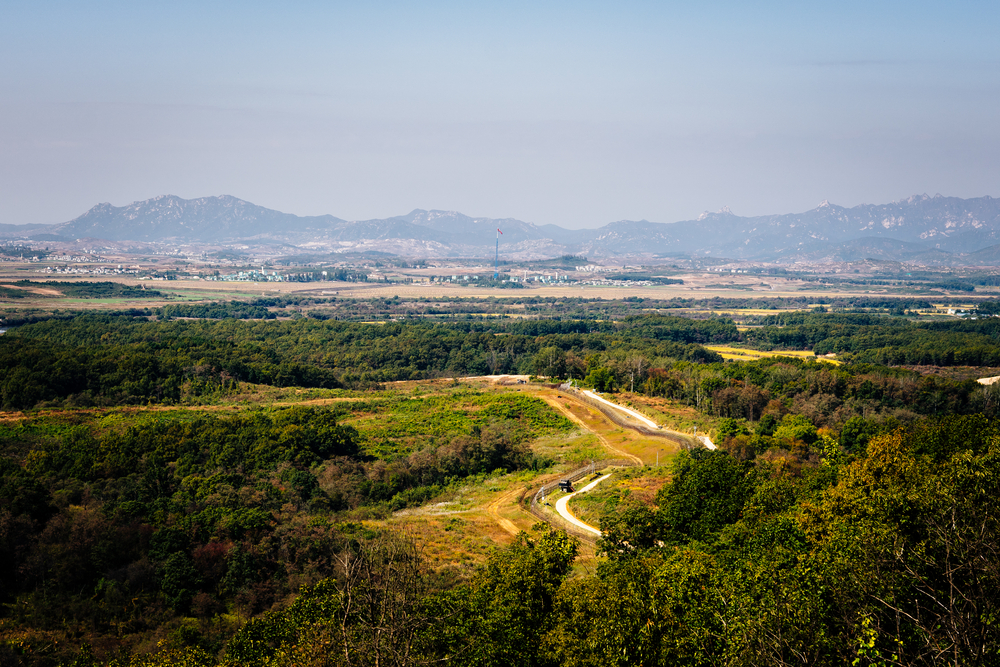The Korean Demilitarized Zone (DMZ) is, ironically, one of the most militarized borders in the world. Laden with barbed wire, electric fences, and landmines, the DMZ serves as a buffer zone between South Korea and North Korea, which have been in conflict (both directly and indirectly) with each other for seven decades. Over the past month, this notorious strip of land has been back in the news after it was reported that US soldier Travis King crossed into North Korea. It’s certainly unusual news, but not the first time such a thing has occurred.
To understand the gravity of the situation, you have to look back to the Cold War and one of its most significant proxy wars, the Korean War.
Korea had been occupied by the Japanese Empire since 1910. Following Japan’s surrender in World War Two on August 15, 1945, the US and the Soviet Union divided Korea into two zones. Amid Cold War tensions, each zone saw two separate governments emerge in 1948 and war spilled out in 1950. The north was backed by the communist world powers, China and the Soviet Union, while the south was supported by the US and its allied capitalist countries. It was a bloody war, leaving millions dead, and it left the Korean Peninsula in ruins.
When the fighting of the Korean War ended in 1953, the Korean Armistice Agreement ordered that the Korean Peninsula will be split in two, roughly halfway along the 38th parallel. The DMZ would be set up as a buffer zone. Decades on, it remains there as the only thing separating the two states, whose military tensions with one another are still red-hot.
Today, the DMZ consists of a 250-kilometer (160-mile) long strip of land that’s about 4 kilometers (2.5 miles) wide. In the absence of humans, wildlife has been thriving here, but much of the land is still riddled with landmines and lined with heavily militarized fences.
The symbolic epicenter of the DMZ is the Joint Security Area (JSA), aka Panmunjom, the only portion of the area where North and South Korean forces stand face-to-face.
It’s most famous for hut-like conference buildings painted bright blue, the color of the United Nations. The border between the North’s half and the South’s half – known as the Military Demarcation Line – runs through these shared conference buildings and marks an absolute cut-off point between the two states.
It’s here where US soldier Travis King reportedly crossed into North Korea’s half of the DMZ, according to Reuters.
Looking over the DMZ from the South Korean side.
Image credit: Guillaume B/Shutterstock.com
King was due to fly home to the US where he would be facing military disciplinary action on his return to Fort Bliss, Texas. As per BBC News, he had just served two months in detention in South Korea for assault charges and was released on July 10.
Just before boarding his flight home from an airport in South Korea, he escaped. He somehow evaded airport security and managed to join a South Korean tourist trip to the DMZ. There are even photographs that show King on a guided tour of the JSA on July 18. At some point during the tour, he dashed across the Military Demarcation Line through the JSA and made it into North Korea where he is currently being held.
The JSA has seen much of the action in the ongoing Korean conflict since 1953. With tensions between North and South still sky-high, it could become a hot spot for drama again.
One of the most infamous events occurred on August 18, 1976, when two US Army officers, Captain Arthur Bonifas and First Lieutenant Mark Barrett, were killed by North Korean soldiers in the JSA.
The incident emerged when American and South Korean forces were ordered to prune a large poplar tree near the JSA, which North Korea claimed was planted by their leader Kim Il-sung. Offended by the move to trim the tree, North Korean troops emerged, a conflict broke out, and the two US soldiers ended up being axed to death. It’s often said that this incident very almost escalated tensions into another full-blown war.
The DMZ is also where numerous defections have taken place. Over the past seven decades, thousands of people from North Korea have fled to South Korea. However, owing to its heavy military presence, very few have traveled across the DMZ. According to the Wall Street Journal, just 20 defectors since 1996 have used the DMZ as their exit route to South Korea.
It still does happen, though. In 2017, a North Korean soldier crossed the JSA in an attempt to defect to South Korea. He was reportedly shot numerous times by North Korea as he did so. When recovering in a South Korean hospital, doctors reported that his intestines were infected with an “enormous number” of parasites.
Likewise, a handful of US soldiers based in the south have fled the other way. At least six US soldiers have reportedly defected to North Korea. Most of these were in the 1950s and 1960s, with the last known defection occurring in 1982. As per Reuters, five of the six crossed through the DMZ.
It’s unclear what King’s motive was for crossing into North Korea, but the US is investigating the possibility that he too was hoping to defect to North Korea.
All “explainer” articles are confirmed by fact checkers to be correct at time of publishing. Text, images, and links may be edited, removed, or added to at a later date to keep information current.
Source Link: US Soldiers Have Crossed The DMZ To North Korea Before, Just Like Travis King
